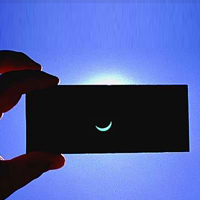
The partial eclipse of the Sun on 20 March has a special resonance with academic and public life here in Birmingham. As the Moon blocks out 90% of the light from the Sun, astronomers from the University of Birmingham's "Astronomy in the City" team will join the public across the city to enjoy the spectacle.
In Birmingham Cathedral Square we will join in celebrations of the 300th anniversary of the Cathedral, reflecting on the amazing fact that an eclipse of the Sun was also seen from Birmingham back in 1715. It promises to be a wonderful community event, with great opportunities for commuters to join in the fun. (Of course, remember that whereever you watch the eclipse, be sure to wear protective eclipse glasses - never view the sun directly with your eyes).
This year of 2015 is also an important scientific anniversary. One hundred years ago Albert Einstein published his General Theory of Relativity. The first evidence to support Einstein's new theory was obtained during the 1920 Solar eclipse by Arthur Eddington. Literally the path of light from a distant star was bent by the gravitational field of the Sun, an effect known as gravitational lensing. Today, astronomers in the University of Birmingham's Astrophysics and Space Research Group use gravitational lensing in their research into the invisible contents of the Universe... namely dark matter and dark energy. We are also excited by the prospect of detecting gravitational waves - ripples in space time itself - in the next several years. Einstein's theory predicts these ripples and yet they have not been detected so far.
Dr Graham Smith, Reader in Cosmology, School of Physics and Astronomy.